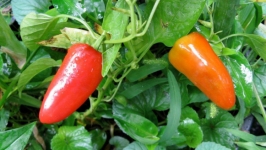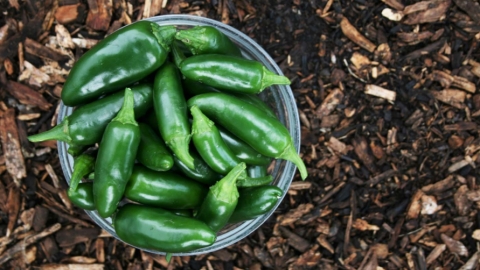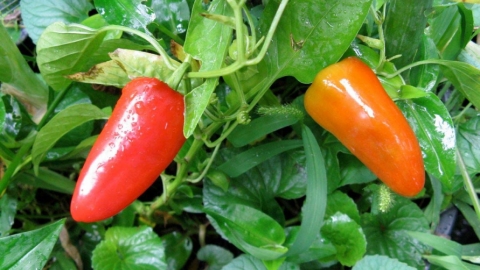How Hot Peppers Benefit the Body
Experiencing the heat of a spicy meal is hard to forget. The burning feeling on your tongue leading to watering eyes and the urgent need to quell it with something— anything—that will ease the pain. For some, it’s something that’s tried one time only. For others, it’s an exciting challenge that dares the palate.
For Tom and Kristin Spies, owners of Cross Country Nurseries in Stockton, it’s much more the latter.
“Some peppers are so intense that they take over your mouth instantly,” says Tom. “Some are a slow build, while others have a heat that feels sharp as a needle.”
More and more people are learning to love hot peppers because it’s fun to experience all the different varieties and their varying heat levels.
At Cross Country’s farm, it’s easy to find a pepper to suit your taste and preferred temperature—they grow almost 500 varieties including sweet, mild, medium, hot, and super-hot.
Tom and Kristin have seen a growing trend in people being interested in the super-hots—like Carolina Reaper, Dragon’s Breath, Apocalypse, Cyclone, and Georgia Flames.
For the hot pepper newbie, they recommend starting out with Fresno peppers.
“It’s a good gateway pepper,” says Kristin. “It’s a step up from a jalapeño or serrano level of heat,” she says, adding that Fresno sauce, which is made by blending the peppers with sour cream or mayo, is an easy (and less intense) way to enjoy them. “Mixing the peppers with dairy helps dilute the heat since capsaicin is fat soluble,” she says. Capsaicin, an oil-like compound in peppers that make them spicy, needs fat to bind to in order to dissipate the heat in your mouth—which is why chasing a spicy meal with water or beer will not help.
Botanically speaking, peppers are technically a fruit as the seeds are on the inside. Contrary to popular belief, the heat typically lies in the pith rather than the seed, with the flavor mainly existing in the flesh. The super hots, however, have heat everywhere, including the flesh.
“SOME PEPPERS ARE SO INTENSE THAT THEY TAKE OVER YOUR MOUTH INSTANTLY. SOME ARE A SLOW BUILD, WHILE OTHERS HAVE A HEAT THAT FEELS SHARP AS A NEEDLE.”
To properly taste a hot pepper, it’s best to start at the base.
“When eating a pepper, work your way up,” says Tom. “The first bite won’t be spicy and you’ll experience the flavor. Once you get up to the pith, then you’ll feel the heat,” he says, explaining that the misconception about the seeds having all the heat is because there’s a lot of pith that surrounds the seed.
When drying peppers and pulverizing them to make powders, the couple wears masks and respirators.
“You have to fear and respect them,” he says. “There’s excitement and adrenaline in surviving the heat.
The spiciness of peppers is measured using Scoville Heat Units (SHU).
A bell pepper has a Scoville rating of zero, while a jalapeño pepper typically rates 2,500—8,000 SHUs. Habanero peppers are rated at 100,000—350,000 SHU, and the Carolina Reaper Chili pepper tops the charts with 2,200,000 or higher rating.
“A little goes a very long way,” says Nicole Piazza, MS, RD, chef and co-owner of The Clean Plate Kitchen in Clinton. “Hot peppers are potent sources of capsaicin, which is not only the element that produces the heat, it is also a tremendous source of antioxidants and healing properties as well.”
Peppers are nightshades, a broad group of edible flowering plants in the Solanaceae family, whose cousins include potatoes, eggplants, and tomatoes. Piazza explains that peppers are very high in antioxidants and nutrients including vitamin C, B6, potassium, and vitamin A. Since hot peppers are consumed in such small quantities, they do not significantly contribute to your micronutrient intake.
“However, capsaicin has some unique properties that, when extracted, can be used to assist with reducing topical pain,” says Piazza. “Studies have shown that it may also assist with decreasing calorie intake by making you feel more full, which can help promote weight loss when combined with a healthy lifestyle.”
Piazza adds that while chiles have an important role in culinary dishes and nutritional benefit, it’s important to note that not everyone can tolerate them, and some may find them irritating to their digestive tract.
Whatever your taste for adventure, take a chance by giving hot peppers a try—and remember: Breaking a sweat also helps keep you cool.
“Hot peppers are hearty and can be stored for a long time. There are many ways to preserve them, from powders, sauces, and jellies to freezing them whole. You can also roast them and hang them up to dry—but do so in a well-ventilated area or outside so they don’t get moldy. If making hot pepper powder, use a spice grinder but wear a mask to protect yourself from any airborne powder.”—Tom and Kristin Spies, Cross Country Nurseries, Stockton









